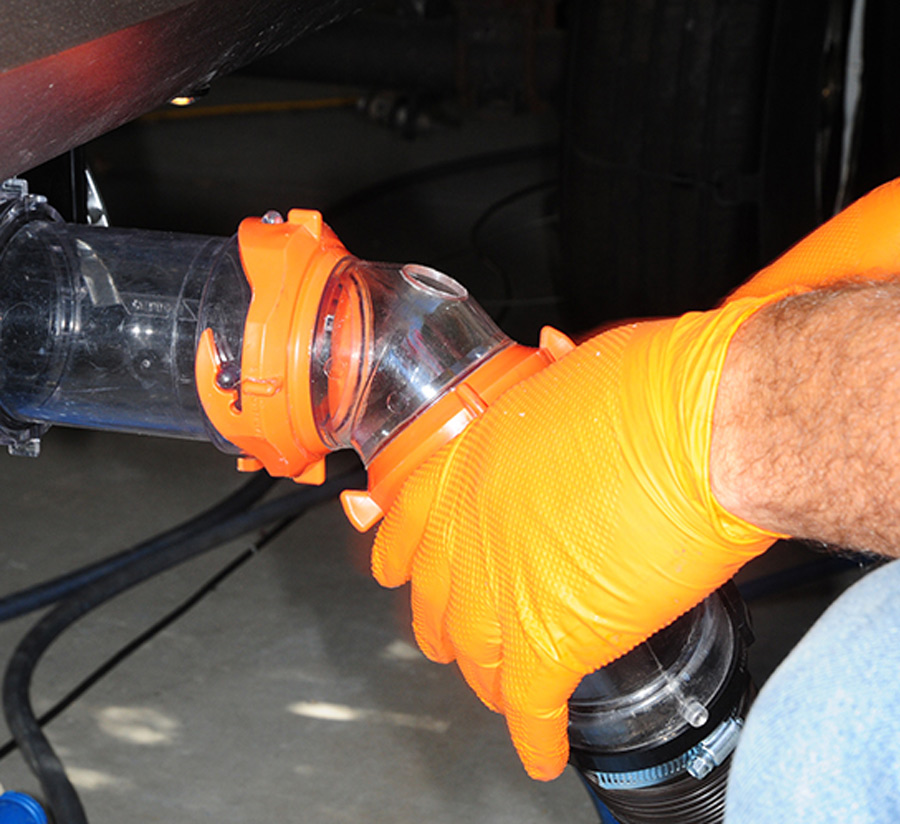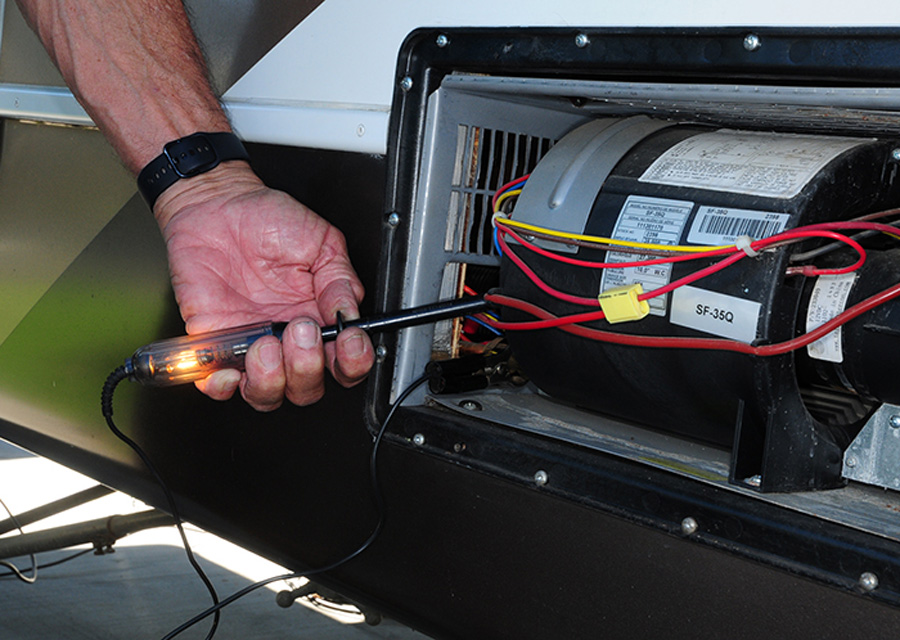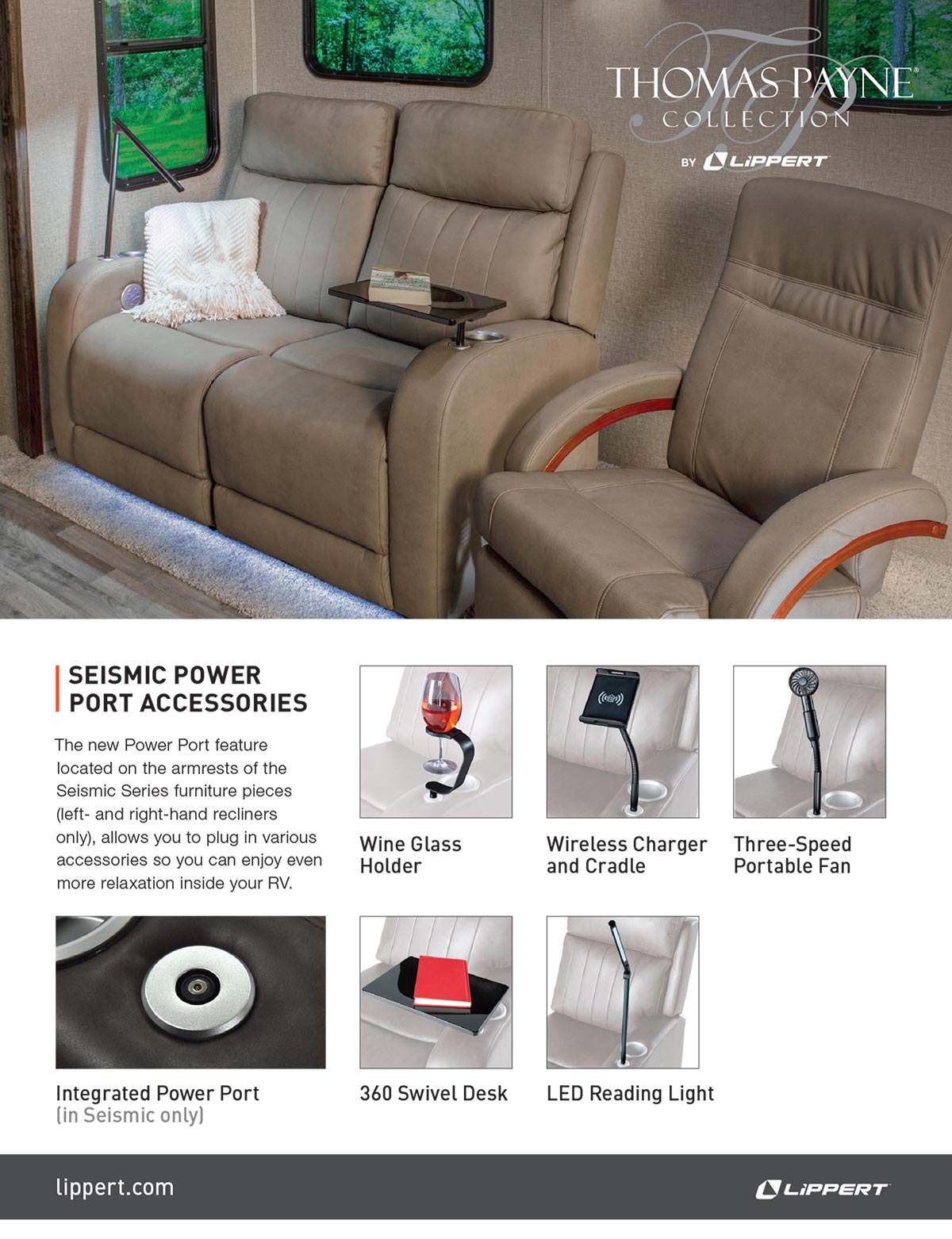Subscriber Access Only
Special Offer
Get 1 year of RV Enthusiast Magazine for just $9.99
Unlock My Offer No ThanksAlready a subscriber? Click here to access full issues.












Off-grid Capable
Heated Enclosed Holding Tanks
Ready to Roll Anytime & Anywhere

Forget about cars. For the bulk of the North American market, trucks and SUVs are where it’s at. And if you’re in the market for a new tow vehicle — to say nothing of more performance and luxury — our RV-focused guide to the newest, coolest, and most capable tow vehicles for the new year should be required reading.
Winter camping is fast becoming the newest trend in the RV world — but unlike a brick-and-mortar home, RVs can lose a lot of heat down below. Using heavy-duty skirts to prevent heat-robbing wind from flowing under your fifth wheel is key to a warmer, less expensive winter.
You can be fastidious about running water and using a cleaning wand in your black-water holding tank, and you still won’t get it really clean. And what about your gray-water tank? It builds up gunk as well. An annual high-pressure flushing prevents waste build-up — and reduces odor.
The time to discover that your furnace isn’t up to the task of keeping your rig warm is not when you turn it on. A furnace can fail for a lot of reasons, from inadequate gas pressure to bug nests. Knowing the top 10 problems — and how to rectify them — will help keep your RV’s interior warm and toasty.
Photo by Bruce W. Smith
“Start surge” is an often-misunderstood aspect of RV air-conditioning that pushes the A/C’s initial power needs beyond the capacity of small portable generators. Reducing that power requirement with a SoftStart RV device adds off-grid versatility by making the impossible, possible.
No, you don’t absolutely need to install a light to illuminate your holding-tank termination pipe/valve area. But take it from us: This is a fun and easily accomplished installation that, once completed and used, will make you wonder how you ever managed to go camping without it.
Part 2 of our sojourn across America in search of the best transportation museums begins in Montana and won’t end until we cross the Wyoming state line. As a bonus, we added Washington, D.C. and its amazing historical repositories to the mix. Buckle up — it’s gonna be a great trip!
One drawback to modern living is that we’ve grown so accustomed to things just working that we’re lost when they don’t. Some you can live without, at least temporarily — but your motorhome’s A/C generator isn’t one of them. When it bites the dust, here’s how to swap in a new one.
(800) 830-9729 ext. 3
[email protected]
EDITOR – Bruce Hampson
(574) 584-4616
[email protected]
TECHNICAL DIRECTOR
Chris Dougherty
(800) 830-9729 ext. 5
[email protected]
TECHNICAL EDITOR – Chris Hemer
(800) 830-9729 ext. 6
[email protected]
SOCIAL MEDIA DIRECTOR – Jim Mac
(800) 830-9729 ext. 7
[email protected]
ART DIRECTOR – MIKE ACCUARDI
[email protected]
120 Atwater Road, Springfield, MA 01107
 AFFILIATE NOTICE: RVE Media Group LLC provides links to vendors and products, such as an Amazon Associates account, for informational purposes, but that may provide a commission if you purchase from that link. We often label these links with language that provides transparency if the destination is an advertiser, affiliate, or partner. Products are often provided to RVE at little/no cost for editorial testing purposes by vendors/suppliers. Under no circumstances does this affect the results of the test or install as published in RV Enthusiast. Sponsored content is identified as such directly on the content.
AFFILIATE NOTICE: RVE Media Group LLC provides links to vendors and products, such as an Amazon Associates account, for informational purposes, but that may provide a commission if you purchase from that link. We often label these links with language that provides transparency if the destination is an advertiser, affiliate, or partner. Products are often provided to RVE at little/no cost for editorial testing purposes by vendors/suppliers. Under no circumstances does this affect the results of the test or install as published in RV Enthusiast. Sponsored content is identified as such directly on the content.
PRIVACY POLICY: Our complete privacy policy can be found at https://rventhusiast.com/privacy-policy/
ou can always tell who the hard-core RVers are when the holidays roll around. They’re the ones who continue to drink out of a Yeti tumbler with a safety lid on even though their RV has been winterized and is safely tucked away for the winter, decorate their trees with travel trailer party lights and find themselves still reaching for the unbreakable Melamine dinnerware when setting the table. They’re also the ones whose “wish lists,” once peppered with requests for the latest cell phones or touchscreen tablets, now include camping griddles, socks stitched with “I’d Rather be RVing” across the soles, “campy” T-shirts and maybe a gift subscription to RV Enthusiast magazine.
If you number among these fine folks, I have a question for you: What ‘present’ are you buying your RV this year?
No, I’m not being facetious or poking fun at the spirit of the season. It’s a serious question, because this really is the best time of the year — and, sometimes, we overlook a few things when caught up in the festivities. Chief among them? Scheduling maintenance and repairs now.
We’ve all probably heard horror stories — if you want to call them that — of RVers who opened up their rig in preparation for a long-awaited trip only to realize certain components weren’t up to snuff. They then did what any of us would: They called their local dealership to schedule service — and found out it would be six or eight weeks before they could be fit in. Goodbye vacation. I’d like to say things are getting better and, well, they eventually will. Before that, though, they’ll probably get worse.

This hasn’t been lost of European manufacturers, where because of space constraints and narrow roads smaller RVs rule the roads. Just how small they tend to be is evident with the Winghamm Oasi 540, coming soon to a dealership near you.
In July, Italian-based RV manufacturer Winghamm announced plans to bring the company’s Oasi 540 stateside, through an exclusive distribution deal with TM Motorhome Sales, LLC. The first two dealerships are Walt Whitman Shops in Long Island, New York, and Santa Monica Place in Santa Monica, California, with plans to go nationwide. According to the company, the Oasi 540 is the first “Micro Class” RV, so named for their diminutive size: the Oasi 540 is just 17 feet, 9 inches long — shorter than a typical Ford F-150 pickup — while still having a full bath and the ability to sleep four.
RVs In the Spotlight at 2021 SEMA Show
By Bruce Hampson

For anyone with premium fuel running through their veins, the annual SEMA Show in Las Vegas is Nirvana — a place where cosmetic components may have taken center stage in recent years but horsepower is still king. SEMA — which started out as the Speed Equipment Manufacturers Association but now stands for Specialty Equipment Market Association — was formed by a number of automotive performance icons in 1963 to showcase the West Coast car culture. The first show, with 98 manufacturers manning booths, was in 1967, held in the basement of Dodger Stadium in Los Angeles. It now occupies more than one million feet square feet at the Las Vegas Convention Center and is considered one of the largest automotive trade shows on the planet.
And, yes, as a trade show, it’s closed to the public.
That doesn’t mean that you can’t learn — quickly — what happens there. The SEMA Show attracts upwards of 120,000 attendees annually — and about 3,000 of them are media folks reporting on what they saw among the 2,000 or so exhibitors.
orget about cars.
For the bulk of the North American market, trucks and SUVs are where it’s at. If you don’t believe us, check the Ford website, where you can choose from either the lonely Mustang…or one of eight crossovers/SUVs. You’ll find a similar story on the Chevy website, with choices limited to a ho-hum Malibu or diminutive Spark, but a total of seven crossover/SUV models. Toyota still offers several passenger car models — but its top selling car, the Camry, has taken a back seat to the RAV4 SUV in total sales.
When your budget only allows for one family vehicle, it all makes sense — a truck or SUV can accommodate a family, haul cargo, tow a trailer and travel competently off-road. Combine these benefits with a higher seating position for better visibility, available 4WD/AWD and the perception of greater crash worthiness, and it becomes clear that a crew cab pickup or SUV is the one vehicle that can do it all for most families — especially those that enjoy RVing. With that in mind, we’re presenting this guide to the most noteworthy offerings for 2022. By that, we mean we’re only going to cover the trucks and SUVs that are either new or significantly changed; if it’s not on this list, revisions for 2022 are limited to appearance and/or content, such as trim, packages and the like.

Preventing heat-robbing breezes from flowing under your fifth wheel is one key to a warmer, less expensive winter
f the professional weather prognosticators are correct in their predictions for the U.S. 2021-2022 winter, the jet stream that carries storm fronts in from the Pacific Ocean and the Arctic will be dipping deeper into the Midwest this season — and bring with it colder-than-average temperatures across much of the country.
At the same time, natural gas prices — of which propane is a natural byproduct — continue to rise. By some estimations, the cost of natural gas has increased by more than 180% compared to just a year ago. These two factors don’t bode well for anyone who continues to enjoy the RV lifestyle once the snow starts flying. But there are ways to “survive” quite easily in cold-weather conditions.

f the professional weather prognosticators are correct in their predictions for the U.S. 2021-2022 winter, the jet stream that carries storm fronts in from the Pacific Ocean and the Arctic will be dipping deeper into the Midwest this season — and bring with it colder-than-average temperatures across much of the country.
At the same time, natural gas prices — of which propane is a natural byproduct — continue to rise. By some estimations, the cost of natural gas has increased by more than 180% compared to just a year ago. These two factors don’t bode well for anyone who continues to enjoy the RV lifestyle once the snow starts flying. But there are ways to “survive” quite easily in cold-weather conditions.





ealing with the sanitation system in an RV requires a little more “up close and personal attention” than in a stationary home. Whereas the attention to a typical residential system ends with the flush of a toilet, good holding tank health in an RV requires owners to act proactively — and constantly — in order to prevent unwanted holding tank and dumping issues—not to mention noxious odors.
Proper dumping procedures can mitigate problems with holding tanks, and many RVs these days are fitted with a flushing system that can rinse away much of the contents and attempt to keep the monitor sensors clean. That said, water under standard spigot pressure can do only so much — leaving more residue than desired on the walls and floor in the tanks — and the overwhelming majority of RVs are not equipped with a flushing system for the gray tank(s). Counter to conventional thinking, build up in the gray tank(s) can actually be dirtier than the black, leading to odors emanating from sink drains that are hard to treat. The solution: Have the tanks pressure cleaned at least once a year by a company like RV Flush, which specializes in holding-tank cleaning and sanitation-system restoration.

inter can be a special season to travel in an RV — and when the temperature drops, modern comfort heating systems will keep the interior cozy. Granted, there are a number of ways to warm up the interior, but most RVers rely on their LP-gas furnaces. Everything is copesetic when they work, but when something goes awry, it can be a challenge to keep occupants comfortable inside the RV. That’s why it’s important to have at least a basic understanding of what can go wrong and how to mitigate the situation — even when on the road, far from service centers.
Most owners will never become an ace furnace repair person, but having the solutions to the following 10 common maladies (in no particular order or importance) in your “pocket” could make the difference between a nice trip and being sidelined, shivering under a blanket. The following applies to typical furnaces found in RVs. Hydronic and Truma models are not covered here.

iven the surging popularity of boondocking, it’s not surprising that sales of portable generators have likewise jumped of late. After all, camping off the grid doesn’t always mean camping without life’s comforts — especially air conditioning. Unfortunately, some RV enthusiasts have found themselves with a fairly expensive genset incapable of keeping things cool in the dog days of summer…through no fault of their own.
Picture this: You bought a new 2,500-watt generator for your RV travels that you believed should be able to provide enough power to operate an air-conditioner. After all, it provides 20 amps of current, and the A/C only requires 13 amps to run. Piece of cake, you think to yourself; “If I need the A/C I just won’t run anything else.”
Famous last words. You start the generator, hook up the RV, and all is good — until you turn on the A/C and the generator gives up the ghost.

umping the holding tanks or routing hoses and TV cable at night can be clumsy — and sometimes frustrating — due to the lack of lighting. It’s one area that manufacturers seem to have ignored when it comes to otherwise installing strategic lighting fixtures around an RV. Sure, a flashlight will work, but unless you’re wearing a headlamp you’ll find yourself running out of hands.
Searching for some type of inconspicuous lighting fixture that could be mounted on the skirt above the holding tank termination pipe/valve turned up a real unexpected find: daytime running lights. While perusing Amazon, we discovered small LED lights that are marketed as—are you ready? — YUK 10x 12SMD 12W Eagle Eye DRL LED Rock Lights for Jeep ATV Off Road Truck Under Trail Rig Lights White (https://amzn.to/3FCb9PY). You’ve got to love overseas manufacturers for their descriptive names for products.
And, they were really inexpensive. Anytime you can buy 10 lights for $13, you’re taking a flyer whether the product is any good — and when you read the reviews, you’ll wonder. But these lights are actually pretty nice, and so far they are still working. But who cares? Even if the light only lasts for one season, you have nine more waiting in the wings.

merica seems to have a love/hate relationship with history. While historical architecture falls all too often beneath the wrecking ball in pursuit of the “next best thing,” we nonetheless try to preserve our past in museums — sometimes successfully, sometimes not.
It’s not for a lack of effort — or for want of subject matter. Simply input “museums” and any state into an online search engine and the wealth of topics can be overwhelming. You can find the National Hobo Museum in Britt, Iowa, the Boot Hill Museum in Dodge City, Kansas, the Mob Museum in Las Vegas, the New Hampshire Telephone Museum…even the Historic Voodoo Museum in New Orleans, Louisiana.
There are two categories, though, that American museums really take to heart: music and transportation. For example, venture into Mississippi — long considered the birthplace of the blues — and you can find information on the Gateway to the Blues Museum, the Rock and Blues Museum, the Highway 61 Blues Museum, the Mississippi Music Museum, the Grammy Museum Mississippi, the B.B. King Museum and Delta Interpretive Center, the Delta Blues Museum and Elvis Presley’s Birthplace & Museum and the Blues and Legends Hall of Fame. And no, this isn’t all of them.
hink about the last time there was a power outage in your area — and the number of times you inadvertently flipped a switch, expecting the light to go on. After the third or fourth time, you likely chuckled to yourself, feeling silly for not remembering that the situation has not changed.
This is how dependent we have become on good, reliable power — we take for granted that it will always be there. In our homes, we usually don’t have to suffer without power for too long before the local utility company comes to the rescue, but if you’re boondocking in an RV and the power goes out, it’s a different story. A non-functioning AC generator can mean anything from an inconvenience to a potentially life-threatening situation.
A generator’s reason for being is to run frequently under load to create 120-volt AC power for appliances like the air-conditioner, microwave, hair dryer and coffee maker. Its enemy is dormancy; to sit unused for months at a time can create numerous problems, from hard starting and rough running to not starting at all. That’s why most generator service professionals recommend that a generator be run at least once a month under load for half an hour or more to make sure it can be relied upon for your next trip.

RVibrake Releases the Shadow


he state of Arizona is home to 22 Native American tribes, each living on their own tribal lands (reservations). The largest of these reservations is the Navajo Nation Tribal Land, located in the northeast corner of Arizona. On this reservation lies one of the Navajo’s holiest sites, Canyon de Chelly (pronounced de-shay) — a canyon that exudes a quiet magic and spirituality. This area was carved out over the course of millions of years by water flow from the Rio de Chelly in addition to years of land uplifts, which created the colorful sheer cliff walls. The canyon cliffs glow pink, yellow and orange and offer breathtaking scenery.
This Navajo holy site is one of the longest continuously inhabited landscapes in North America. Evidence of the first settlers, the Anasazi Indians (more recently called Ancient Puebloan people), who lived in pit houses in the canyon around 1150 A.D. Later, the Anasazi moved from pit houses to building homes in the caves and alcoves of the canyon walls. The remains of numerous multi-storied masonry dwellings can still be found in the sandstone cliffs of this canyon. By the mid-1300s, the Anasazi people left the canyon and moved elsewhere because of drought conditions. The Hopi tribe then moved into the canyon and planted crops of corn and peaches. Hundreds of years later, the Hopi also left the canyon and moved to the mesa tops. The Navajo tribe later moved into the canyon, created farms on the floor of the canyon, planted crops, raised livestock and built dome-shaped hogans as their homes. To this day, the canyon is still inhabited by Navajo families.































